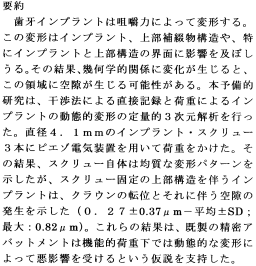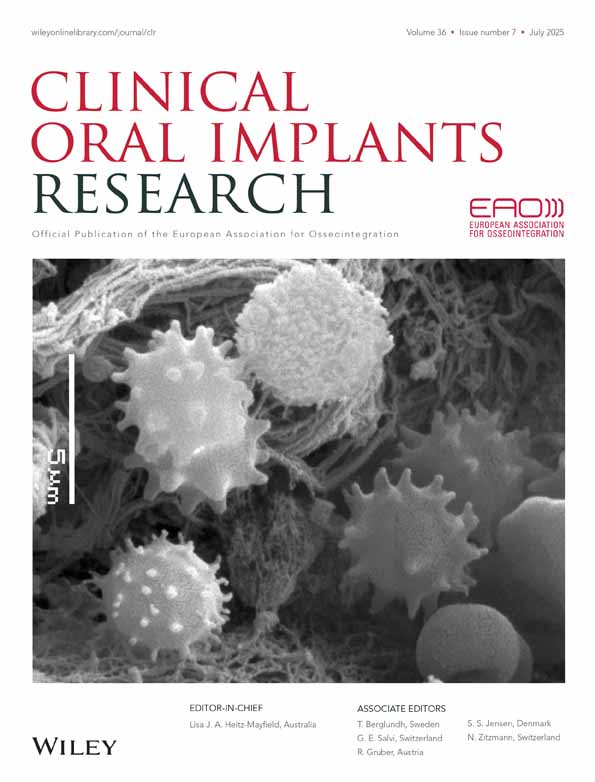Deformation at the implant interface to prosthetic superstructure: an interferometric approach
Abstract:
enDental implants are deformed by masticatory forces. These deformations may affect the implant, the prosthetic superstructure or, in particular, the interfaces between the implant and the superstructure. The resulting changes in the geometrical relationships may lead to gap formation in this region. The objective of the present pilot study was to present an interferometric method for the direct recording and quantitative three-dimensional analysis of load-induced dynamic implant deformation. Three implant screws of 4.1 mm diameter were loaded using a piezoelectric device. The results showed that the screws itself exhibited a homogeneous deformation pattern, whereas implants with screw-retained superstructures demonstrated dislocations of the crown and resulting gap formations (0.27±0.37 μm – mean±SD; max: 0.82 μm). The results supported the hypothesis that the high precision of prefabricated abutments is adversely affected by dynamic deformations under functional loading.
Résumé
frLes implants dentaires sont déformés par les forces masticatrices. Ces déformations peuvent affecter l'implant, la superstructure prothétique ou, en particulier, les interfaces entre l'implant et cette superstructure. Les variations qui en résultent dans la relation géométrique peuvent entraîner l'apparition d'un interstice dans cette région. L'objectif de cette étude pilote a été de présenter une méthode interférométrique pour l'enregistrement direct et l'analyse quantitative en trois dimensions de la déformation dynamique de l'implant produit par la charge. Trois implants-vis d'un diamètre de 4,1 mm ont été mis en charge en utilisant un modèle piézo-électrique. Les résultats ont montré que les vis elles-mêmes avaient un modèle de déformation homogène tandis que les implants avec des superstructures retenues sur des vis accusaient des dislocations de la couronne et entraînaient la formation d'interstices (0,27±0,37 μm, max 0,82 μm). Les résultats soutiennent l'hypothèse que la haute précision de piliers préfabriqués est influencée défavorablement par les déformations dynamiques sous charge fonctionnelle.
Zusammenfassung
deZahnimplantate werden durch Kaukräfte verformt. Solche Verformungen können das Implantat und die prothetische Suprastruktur, in einigen Situationen auch die Übergangsstelle vom Implantat zur Suprastruktur beeinträchtigen. Die daraus entstehenden räumlichen Verschiebungen können an solchen Orten Spalten hervorrufen. Das Ziel dieser Pilotstudie war, eine interferometrische Methode vorzustellen, die eine direkte Registrierung und quantitative dreidimensionale Analyse der belastungsinduzierten dynamischen Implantatverformungen erlaubt. Man brachte an drei Schraubenimplantaten von 4.1 mm Durchmesser piezoelektronische Messinstrumente an, und belastete diese Implantate funktionell. Die Resultate zeigten, dass die Schrauben selbst ein homogenes Verformungsbild aufwiesen, währenddem es bei den verschraubten Suprastrukturen auf diesen Implantaten zu einer Verschiebung der Kronen kam, so dass sich ein Spalt von 0.27+0.37 μm (Mittelwert+SD; Maximalwert: 0.82 μm) bildete. Diese Resultate unterstützen die Hypothese, dass unter funktioneller Belastung dynamische Verformungen der bei der Herstellung von Sekundärteilen erreichten hohen Passgenauigkeit zuwiderllaufen.
Resumen
esLos implantes dentales son deformados por las fuerzas masticatorias. Estas deformaciones pueden afectar al implante, la superestructura prostética o, en particular, las interfases entre el implante y la superestructura. Los cambios resultantes en las relaciones geométricas pueden conducir a la formación de un espacio en esta región. El objetivo de este estudio piloto fue presentar un método infométrico para el registro directo y el análisis cuantitativo tridimensional de la deformación dinámica del implante inducida por la carga. Se cargaron tres implantes roscados de 4.1 mm de diámetro usando un dispositivo piezoeléctrico. Los resultados mostraron que los tornillos por si mismos exhibieron un patrón de deformación homogénea mientras que los implantes con supraestructuras retenidas por implantes demostraron dislocaciones de la corona y formación de espacios resultantes (0.27±0.37 μm media±SD; max: 0.82 μm). Los resultados apoyaron la hipótesis de que la alta precisión de los pilares prefabricados es afectada desfavorablemente por las deformidades dinámicas bajo carga funcional.





